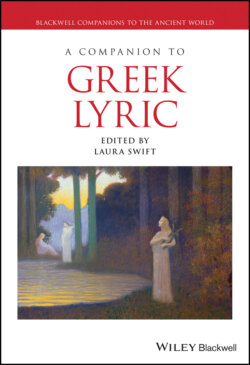Читать книгу A Companion to Greek Lyric - Группа авторов - Страница 39
IX Lyric into Epic, Epic into Lyric: Stesichorus
ОглавлениеIf we are right to see a creative agonism at the heart of this interaction, then it reaches something of a paradoxical climax in the works of the mid-sixth-century Western Greek lyric poet, Stesichorus of Himera, whose songs almost entirely comprised mythological narratives, composed in a variety of dactylic rhythms.49 Their length was extraordinary, next to those of the other lyric poets, with works ranging from 1,500 to 4,000 verses. These facts make him exceptional enough, but he was also unlike other lyricists in not saying much of himself or his contemporary audiences and performance settings in these compositions, and in digging out the less conventional parts of those stories. For example, his treatment of the conflict between Heracles and the monster Geryon focused much more on humanizing the latter than on heroizing his slayer (as, e.g., Hesiod’s story does: Theogony 287–294, 979–983), a choice perhaps unsurprisingly given the poem’s title: Geryoneis or “song of Geryon.”
That is not to say that he did not treat famous, panhellenic myths: his oeuvre included poems with the titles Sack of Troy, Oresteia, and the Returns (of the heroes from Troy), and his interaction especially with Homer was of an extraordinarily sophisticated sort; he took not only formulaic phrases and epic type-scenes such as those we found throughout the lyric tradition, but even unique expressions become the subject of his recreative poetry, such as the simile of the poppy applied to Geryon’s death (fr. 19.44–7 F) drawn from the same, unique, simile image in the Homeric description of the minor warrior Gorgythion’s death (Il. 8.302–308).50 Nonetheless, we can get the clearest picture of his unique stance vis-à-vis the other lyric poets, by turning to his deployment of the Helen myth—a popular theme, as we have seen. Whether his poem Helen was the same as his Palinode (or Palinodes),51 Stesichorus’ treatment represented a broad-spectrum rehabilitation, a response to the critical coverage Helen received in epic poetry—but also to the denunciations in Alcaeus, and the more qualified picture in Sappho. Stesichorus went much further in his exculpation than any previous author: he denied that she had gone to Troy, her place there being taken by a phantom (this, too, is an epic theme, but taken to an extreme conclusion: see, e.g., Il. 5.449–453), and this version would perhaps unsurprisingly leave its mark on later literature, both in Herodotus (2.112–120) and Euripides’ Helen. But unlike his lyric predecessors when they turned their attention to Helen, Stesichorus doesn’t select or allude or compose on a small scale—he massively retells and revises her entire story (perhaps more than once!), and in doing so he shows himself a true modal hybrid, with the scale, self-presentation, and ambition of an epic poet, the delivery and performance contexts of a lyric poet, and the languages and rhythms of both.
* * *
The lyric poets of the Archaic period interacted with epos as well as their own lyric past, and bequeathed to later ages a rich, inter-modal inheritance, opening the way for future experimentation and cross-fertilization between epic and lyric modes of poetic composition. Without this extraordinary, path-breaking period, the next great efflorescence of Greek poetic creativity, the works of Athenian tragedy, would have been impossible.
